AMD Kaveri Review: A8-7600 and A10-7850K Tested
by Ian Cutress & Rahul Garg on January 14, 2014 8:00 AM ESTIntegrated GPU Performance: BioShock Infinite
The first benchmark in our test is Bioshock Infinite, Zero Punctuation’s Game of the Year for 2013. Bioshock Infinite uses the Unreal Engine 3, and is designed to scale with both cores and graphical prowess. We test the benchmark using the Adrenaline benchmark tool and their three default settings of Performance (1280x1024, Low), Quality (1680x1050, Medium/High) and Xtreme (1920x1080, Maximum) noting down the average frame rates and the minimum frame rates.
Bioshock Infinite, Performance Settings
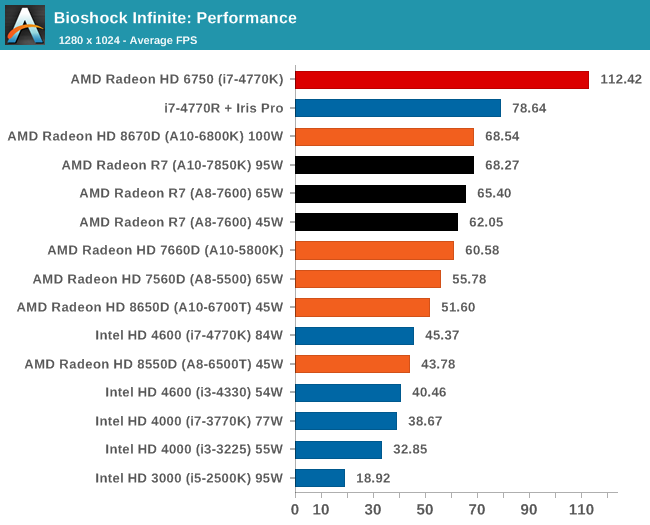
For BI: Performance we see the Iris Pro being top of the IGPs, although the next six in the list are all AMD. The Kaveri cores are all between the 6800K and 5800K for this test, and all comfortably above 60 FPS average.
Bioshock Infinite, Quality Settings

For the quality settings, the Iris Pro starts to struggle and all the R7 based Kaveri APUs jump ahead of the A10-6800K - the top two over the Iris Pro as well.
Bioshock Infinite, Xtreme Settings
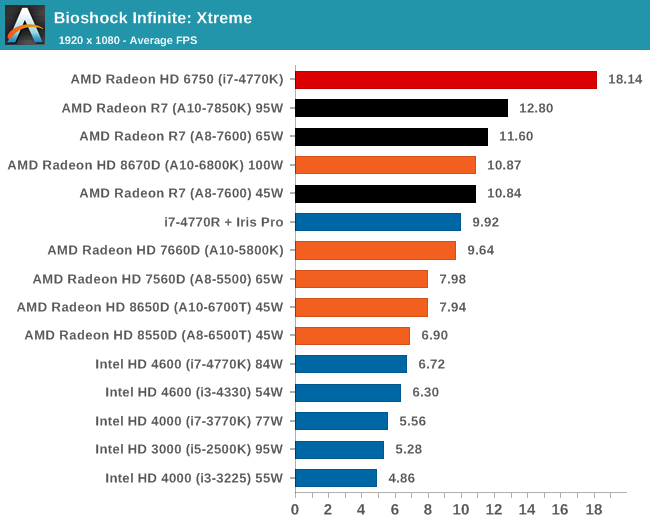
The bigger the resolution, the more the Iris Pro suffers, and Kaveri takes three out of the top four IGP results.
Integrated GPU Performance: Tomb Raider
The second benchmark in our test is Tomb Raider. Tomb Raider is an AMD optimized game, lauded for its use of TressFX creating dynamic hair to increase the immersion in game. Tomb Raider uses a modified version of the Crystal Engine, and enjoys raw horsepower. We test the benchmark using the Adrenaline benchmark tool and their three default settings of Performance (1280x1024, Low), Quality (1680x1050, Medium/High) and Xtreme (1920x1080, Maximum) noting down the average frame rates and the minimum frame rates.
Tomb Raider, Performance Settings
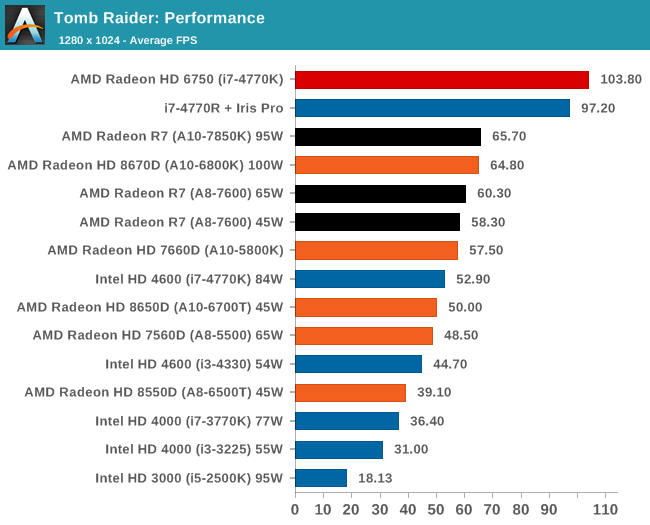
The top IGP for Richland and Kaveri are trading blows in TR.
Tomb Raider, Quality Settings

The Iris Pro takes a small lead, while the Kaveri 95W APU show little improvement over Richland. The 45W APU however is pushing ahead.
Tomb Raider, Xtreme Settings
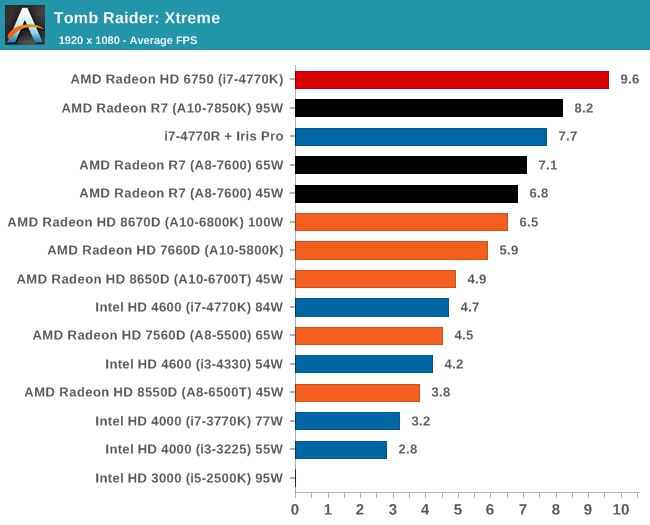
At the maximum resolution, the top Kaveri overtakes Iris Pro, and the 45W Kaveri it still a good margin ahead of the A10-6700T.
Integrated GPU Performance: F1 2013
Next up is F1 2013 by Codemasters. I am a big Formula 1 fan in my spare time, and nothing makes me happier than carving up the field in a Caterham, waving to the Red Bulls as I drive by (because I play on easy and take shortcuts). F1 2013 uses the EGO Engine, and like other Codemasters games ends up being very playable on old hardware quite easily. In order to beef up the benchmark a bit, we devised the following scenario for the benchmark mode: one lap of Spa-Francorchamps in the heavy wet, the benchmark follows Jenson Button in the McLaren who starts on the grid in 22nd place, with the field made up of 11 Williams cars, 5 Marussia and 5 Caterham in that order. This puts emphasis on the CPU to handle the AI in the wet, and allows for a good amount of overtaking during the automated benchmark. We test at three different levels again: 1280x1024 on Low, 1680x1050 on Medium and 1920x1080 on Ultra. Unfortunately due to various circumstances we do not have Iris Pro data for F1 2013.
F1 2013, Performance Settings
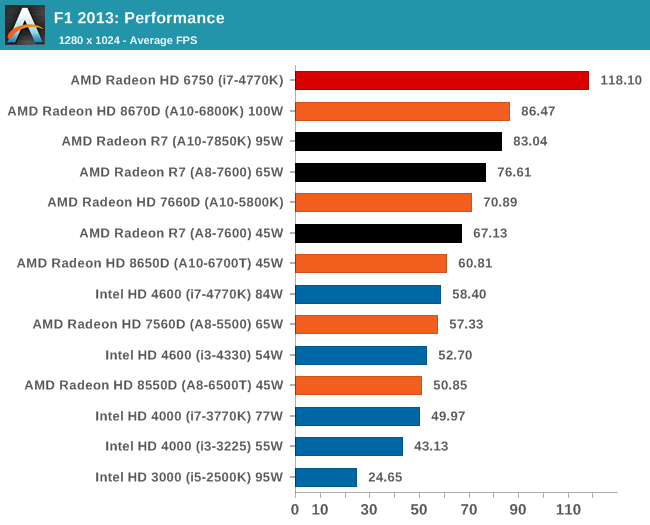
F1 likes AMD here, although moving from Kaveri to Richland at the high end seems a bit of a regression.
F1 2013, Quality Settings
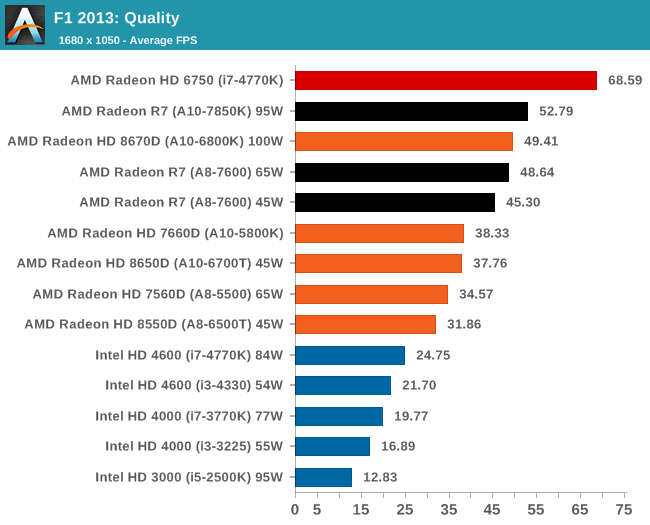
Similarly in the Quality settings, none of the Intel integrated graphics solutions can keep up with AMD, especially Kaveri.
F1 2013, Xtreme Settings

On extreme settings, at 1080p, the top Kaveri APU manages to hit over 30 FPS average during the benchmark. The other A8 Kaveri data is not too far behind.










380 Comments
View All Comments
DanNeely - Tuesday, January 14, 2014 - link
This is the first I've heard that Excavator will be the end of the line for the current AMD core. Is there any information about what's coming next publicly available yet?JDG1980 - Tuesday, January 14, 2014 - link
It's all speculation because AMD hasn't released any roadmaps that far in advance. If I had to guess, I'd say they will probably beef up the "cat" cores (Bobcat -> Jaguar, etc.) and use that as their mainstream line. That would be similar to what Intel did when they were faced with a situation like this - they scaled up the mobile Pentium M to become the Core 2 Duo.jabber - Tuesday, January 14, 2014 - link
The great shame of these chips is the real market they should be selling in will never take off. These are perfect all round chips for those folks that buy a family PC in the usual PC mega store. That family PC would be your usual Compaq/Acer desktop with a decent enough Intel chip in it but the crappy Intel IGP only.But as AMD never advertises to these people (the people who should be buying this stuff) they will never buy them. The demand will never appear. They have heard of Intel, they hear the Intel jingle on the TV several times a week. But AMD? Never heard of them, they cant be any good.
Has anyone at Anandtech ever got round to interview the lazy idiot in the AMD marketing dept? Does AMD really have a marketing dept?
AMD, sometimes you do have to push the boat out and make the effort. Really stick it under ordinary peoples noses. Don't bother keep brown-nosing the tech review sites cos most of their readers don't buy your stuff anyway.
UtilityMax - Tuesday, January 14, 2014 - link
AMD can't market the APUs directly to the average consumers. They just buy what the PC mega-store sells to them. AMD should convince the OEMs, and that is _really_ hard. First is the issue of Intel quasi-monopoly. Intel always browbeat the major EOMs to ignore AMD. Even after losing the lawsuit, I think this effect still exists. And then next issue is that, your typical average consumer does not play on PC. They play on consoles. In fact, hardly anyone buys a PC box these days. Everyone buys laptops, and AMD's strategy there is just as weak.ThreeDee912 - Tuesday, January 14, 2014 - link
They tried to get OEMs to put Llano chips into "thin and light" laptops, but Intel kind of beat them with their Ultrabook marketing.At least AMD kind of "won" the console wars by getting their CPUs into both the PS4 and XBone.
xdesire - Tuesday, January 14, 2014 - link
Sorry but i read it like this: this is another piece of sht hardware which is YET another disappointment for their fans. I owned many of their CPUs GPUs and stuff but enough is enough. They have been laying their a**es off for SO long and couldn't even make an improvement on their crap stuff. So, is this THE Kaveri we were promised for so long? I supported them in their worst days by buying their products, hoping to see them come back in the game BUT no, they are being lazy and don't improve sht..jabber - Tuesday, January 14, 2014 - link
Dear AMD marketing Dept, the above post signifies what I said in the last part of my last post.This is not the market/customer you are looking for!
jnad32 - Tuesday, January 14, 2014 - link
Actually a 30% performance improvement seems pretty amazing to me. Also please try and remember that all these tests are done with very early drivers. We all know AMD takes forever to get there drivers in line. I wouldn't personally worry about numbers for the next couple of months. BTW, what were you expecting from an APU? Core i5? HA! I am a massive AMD fan, but we all know that wasn't even possible. What I really want to know is where is my 8 core Steamroller chip.JDG1980 - Tuesday, January 14, 2014 - link
I was hoping for IPC in line with at least Nehalem. The low IPC is really killing the "construction equipment" cores, and it's increasingly looking like an unfixable problem. If Steamroller could have brought ~30% IPC gains as was initially rumored, then that would have been a good sign, but at this point it seems they'd be better off taking their "cat" cores and scaling them up to desktop levels, and dropping the module architecture as a failed experiment.silverblue - Tuesday, January 14, 2014 - link
A "construction equipment" (thanks) module actually gets an impressive amount of work done when taxed. The concensus has been to make software think a module is a single core with HT. I imagine that the cores will be fed better in single threaded workloads in that circumstance.I also imagine that a heavily threaded workload will extract the very best from the architecture now the MT penalty is gone.
One question about the review scores - all the testing was done on Windows 7 64-bit SP1 with the Core Parking updates applied. Would using Windows 8 or 8.1 make any real difference to the results or would it just benefit both AMD and Intel?